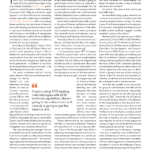The I/ITSEC 2023 spotlight will shift to the topic of human performance later today when Metris Global LLC [Booth 1481] participates in a panel discussion in the Innovation Showcase titled “Why an advanced, agile approach to Human Performance is necessary to keep pace with modernization mandates” [1430-1530, Booth 2588]. With a secondary theme exploring the importance of keeping pace with training process innovation even in cost constrained environments, the panel will look beyond the fielding of next generation technologies to address how warfighters can adapt and adopt to maximize the training benefits of those technologies.
According to Tony Barker, former Chief of Operations for the US Border Patrol and current chief operating officer of Metris Global, the panel discussion will provide “an opportunity to ‘level set’ how critical human performance technologies and training still are to personnel — in addition to the new/ advanced products being introduced — in an often fiscally restricted environment.
The panel moderator will be Timothy Haws, director of human performance technology for Metris Global LLC, with attendees including Barker as well as: Thomas Heckens, former Non-Commissioned Officer with 5th Group Special Forces and founder / chief executive officer of Metris Global); Julie Farnam, former Deputy Director of Intelligence for the US Capitol Police (during the January 6 events at the Capitol); and Timothy Robbins, former acting Director, Enforcement & Removal Operations, Immigration and Customs Enforcement.
“We have amazing technologies that are provided to servicemen and women in order to increase survivability, safety and operational efficiency,” Barker explained. “The technology is great. But the training methodologies and the process management and how you introduce those technologies into operational situations with the human, the actual service member, needs to keep pace. Because if you’re using 1975 training methodologies with 2030 technical capabilities, there’s going to be a disconnect and nobody is going to get the best out of it. That’s why I think this is an extremely important conversation for the panel. It will include specific examples that the country is familiar with, that could have been different if there had been a better and more precise focus on training and processes.”
Barker and moderator Haws both pointed to the value of human performance technology (HPT) and the significance of this afternoon’s panel discussion in learning to avoid that potential disconnect between training technologies and training methodologies.
Haws described his own experience as a 26year US Coast Guard officer with assignments “focused on the training world and human performance technology.”
“I am passionate about HPT,” he began. “I think it’s a great model, but it is underutilized. When you look at the modernization mandates that are hitting the Department of Defense and US Government, they need something innovative. And I believe that HPT is going to ensure that we maximize the human training experience with all of these new technologies being brought on board…There’s a lot happening with AI. There’s a lot happening with distance learning. And with this panel, Metris has focused on things like the training needs associated with those modernization mandates against the societal shift to a much more mobile learning space. How does all of that equate across DoD and the US Government?”
Barker referenced his own experience with the US Customs and Border Protection and Department of Homeland Security, offering, “One of the things that I really think is extremely impressive was not only how Customs and Border Protection as a whole was reacting to the immigration or mass migration challenges that we’re facing along the southwest border over multiple administrations, but also the pipeline of well-trained and qualified officers and agents to put out in the field, and the necessity to produce a highly qualified, highly trained officer and agent as fast as possible to fill those roles. We have mandates for modernization. But those mandates are also on top of a fiscally restrained environment.” He added, “We need to look at how we train differently.” He described today’s panel members as “a very eclectic collection of professionals that we are privileged to have,” noting, “Tim Haws is one of the foremost experts on human performance and having him moderate this and be able to draw out those ‘nuggets’ from the panelists is going to be critical.”
Reiterating his own experience as well as summarizing those of Metris CEO Tom Hopkins, he continued, “Tim Robbins is the former Acting Director of Enforcement and Removal Operations for Immigration and Customs Enforcement (ICE). There are certain pressures with those operations, and making sure that the workforce is trained, equipped and doing what they need to do effectively within the rules of their SOPs [standard operating procedures] to enforce our nation’s laws is so critical, especially with many eyes on them. So he is going to talk about how training is critical to the ICE mission, and especially in a fiscally constrictive environment as you get the polarization within that mission set.
“And the last panelist in our very eclectic group is Julie Farnham. And this will be the first time that Julie Farnham has spoken publicly with regards to her role during the January 6 [2021] events [at the US Capitol]. She was the Deputy Director of Intelligence for the Capitol police on that day. And I don’t want to take her thunder away, but she will talk about how training is so critical to the intelligence and intelligence analysts, as well as some of the successes and failures and how lack of training and lack of preparedness resulted in some of those aspects of January 6. Again, this will be the first time she speaks publicly about that,” he said.
In summarizing his takeaway message, Haws said, “Everybody knows that the Department of Defense and other US Government organizations have modernization mandates. And one of the biggest parts of meeting those mandates is rising to the challenge of exponentially rapidly developing technology. From AI to VR to XR, all of the ‘realities’ have to have the human at the center…And we need to look at ways that HPT can be leveraged to keep humans in the mix.”

